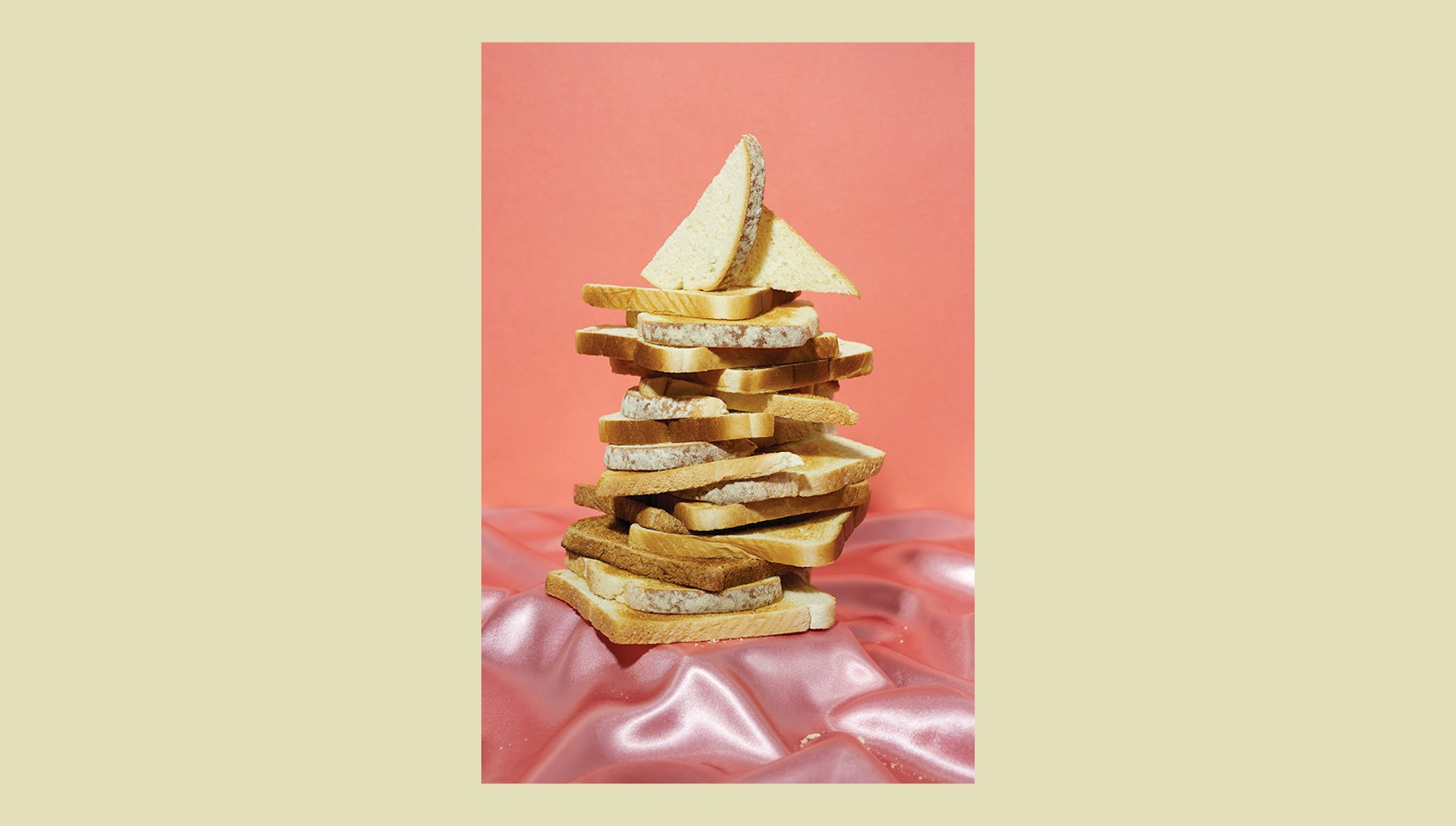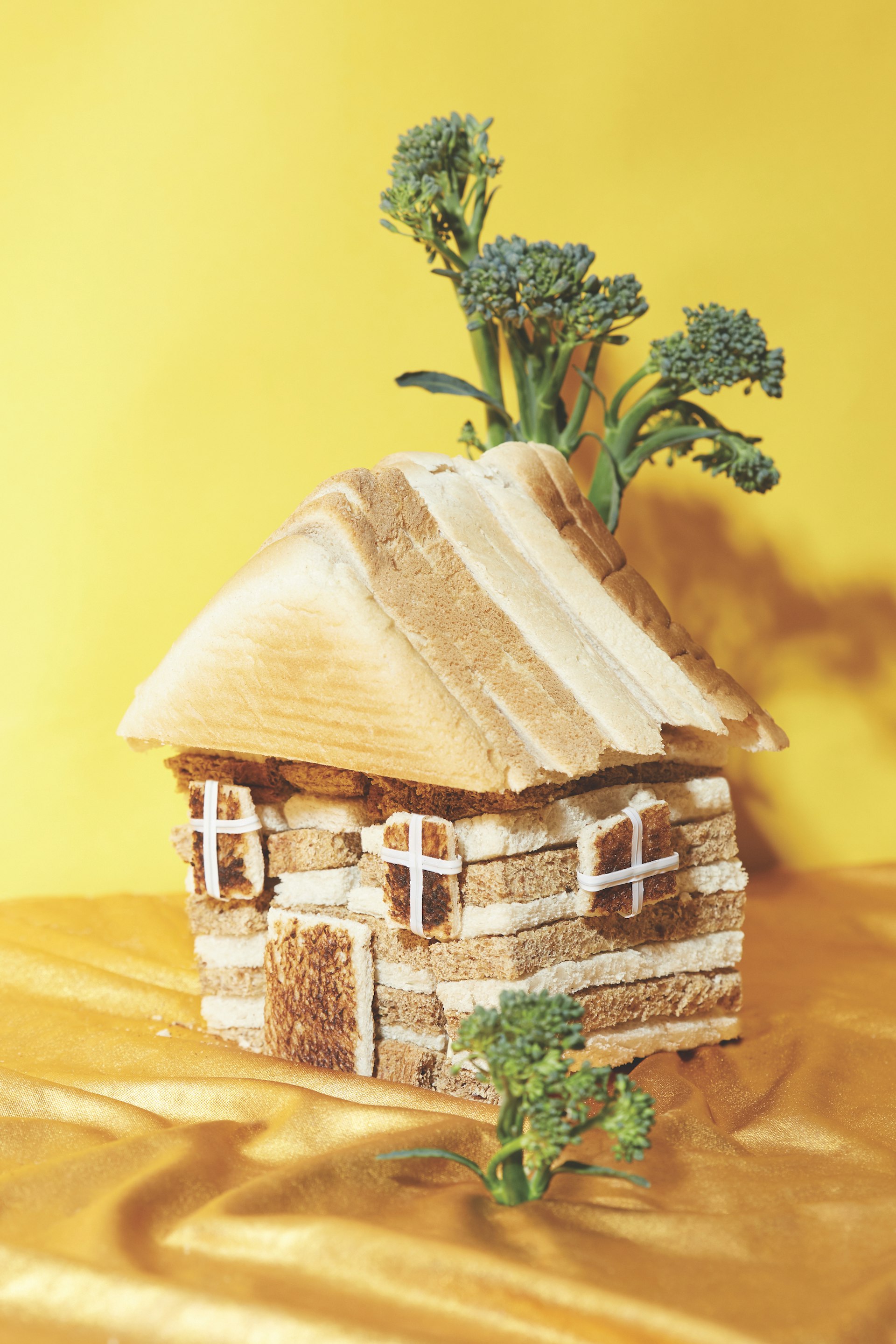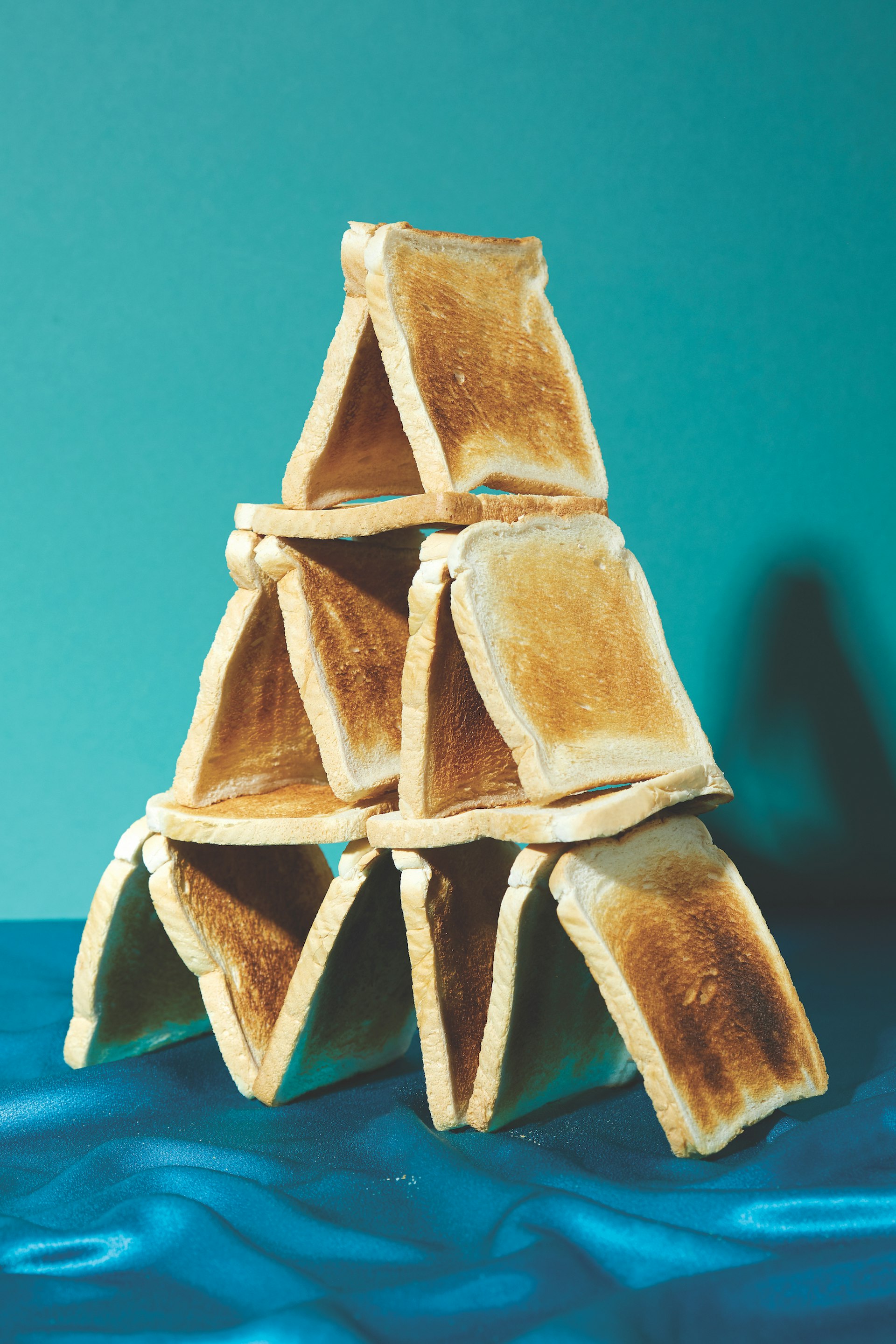
Bread binned: the true number of slices wasted
- Text by David Wright
- Photography by Hannah Slaney
- Illustrations by Han Nightingale
We need to talk about levain. In the UK we throw away around 24 million slices of bread a day. That’s at least 1 million loaves of bread a day. Which is enough to cover 61 football pitches, or if you are tired of people using a football pitch as a benchmark, that’s 310 bungalows made out of the fluffy stuff. How does a nation of bread lovers make peace with this apparent neglect? As the seminal work of literature by Allan Ahlberg, ‘Hooray for Bread’, decrees – “This is the story of a loaf of bread, no need to ask me twice, it’s full of fun and flavour, and I’ll tell it slice by slice.”
Back in the history times before people knew each other’s names — there were forests and grasslands. In Daniel E. Lieberman’s ‘The Story of the Human Body’ he theorised that the forests were fun and pre-people lived in them to stay safe and chew leaves all day. One fateful day our large-jawed relatives got curious and ventured out into the grasslands. They saw other animals lunching on the seeds of grass instead of the grass itself, ever the evolutionary copycats they followed suit and got a bit fatter. Which was good.
Richard Wrangham has us believe in his book ‘Catching Fire’ that after the seed craze they started making fires and began cooking sloppy seed stews. By cooking the starchy nuggets they got fatter still! This became mushing seeds and water and leaving them out because no one had invented washing up yet. The seeds fermented and festered and bacteria digested and got gassy. The sludge rose. When baked it made us fatter than before and this made us sexy. Bread was born. This nutritious, handy snack allowed us to travel, pockets stuffed full of seeds we roamed, planted, made bread, got fat and became sexier than anything in the world.
Bread stayed the same for ages, it was a naturally leavened heavy gift that provided the calories we needed to get cleverer and lazier. Then we got a bit too clever and a bit too lazy. We started fucking around with our old friend. Like humping a childhood teddy bear it was clear to everyone but us at the time that this was wrong.
“In the 1960s we made cheap pappy crap that slowly made everyone sick and intolerant”

We separated the nutritious parts and made it softer and lighter, we used yeasts from brewing to make it faster fermenting and fluffier. We used wheat from different countries like Canada to make it bigger and bigger. Then just as everyone thought we were finished, we dropped the bomb... We made bread that wasn’t even bread. In the 1960s we made cheap pappy crap that slowly made everyone sick and intolerant and above all else it contributed to increased obesity, burying our genitals in subcutaneous fat. If you want to look into this further, then read ‘The Way We Eat Now’ by Bee Wilson. Eating bread made using the Chorleywood bread process (which made it possible to produce a sliced bread from flour to a packaged loaf in mere hours) made people fatter than we could ever have hoped for. Montes pubis across the globe swelled and sexual organs were consumed by the marshmallowy cushions. We’d gone too far. The fatness that had in the early days increased fertility now started to stifle it. The crazy thing is that we still make this shit. We still eat it, and it affects the poorer in society the most. If you can’t afford to buy a loaf of 300-hour sourdough made with flour that’s been milled between two pebbles by someone with a blog then your options are pretty limited.
But what about the wastage? Why is that happening? Well, before we’ve even thrown away the millions of slices it actually all starts in a field somewhere, an ear of wheat, resplendent with plump kernels sings in the wind. Every one of the little capsules contains everything required to renew its lifecycle, the germ, endosperm and bran. You should read the table in ‘Bread Matters’ by Andrew Whitley which shows the nutritional difference between wholemeal flour and refined white flour. It basically reads like the side of a Berocca tube, we extract all the goodness out of something, then buy the stuff we took out of it for wildly inflated prices — capitalist trick #272. It’s here in this sunny field that the wastefulness really begins, aside from the 5% of the yield that's lost there are tonnes of petrochemicals used to drive the machines that sweep through the crops or synthesised nutrients sprayed at various times to boost the yield. These fossil-fuel-derived inputs are made using a process invented by Fritz Haber and Carl Bosch, turning oil into nitrogen. Haber was the grandfather of chemical warfare and is also responsible for creating Zyklon A.
Next up is the miller’s tale. The cleaned and sorted grain arrives in sacks (or trucks) to be cracked, crushed, sieved and sold to bakers across the land. If making wholewheat flour there’s no loss in the milling process according to UK Flour Millers — but we don’t eat wholewheat bread do we? Even if we eat bread with some wholewheat in it, the bulk of the flour is powdery white and free from bran and germ (the two most diversely nutritious components). The milling industry prides itself on a zero waste standard as they cart off the 20% unused chaff for animal feed, which helps livestock grow fat and farty. Nothing bad happens if we feed animals intensively on a diet that isn’t designed for their bodies right? Goody good.
The flour arrives at bakeries in sacks, is packed onto pallets and offloaded at dawn when the baker’s shift has finished and all the bread is on the shelves. Around 16% of the goods produced are wasted at the bakery, whether because the baker made too much dough, the loaves failed to meet quality standards or simply goes unsold. The nature of bread and our expectations require it to be fresh, made daily and this collective ‘fussy knickers’ philosophy helps keep the wastage high. Lots of bread lasts for days but we fetishise the newly born bread babies, crisp to the touch and pleasant to sniff. Supermarket wastage of white bread is surprisingly low at less than 1% (according to Tesco), but as the bread reaches its best before date the price is slashed and bargain hunters swoop to rush the sliced cloudy cube out of the door before it goes stale and mouldy (which happens just after the contactless payment goes through). The manager will smile and wave as you pay to take the waste off their hands for the price of a yellow sticker. Which leads us to the site of the 310 bungalows of daily wasted bread: our kitchens.
“Most of us don’t eat the crusts, and you’ll know if someone does because they’ll go on about it.”

Most of us don’t eat the crusts, and you’ll know if someone does because they’ll go on about it — they account for 10% of a standard sliced loaf. In medieval cookery, stale crusts were used to thicken soups and sauces but we prefer to keep them in the bag, fated to watch the other slices get picked first. Much like Ian Beckett and I every time teams were chosen at primary school. We demand bread as a divine right, however in reality we don’t value it that much. ‘Give us this day our daily bread’... so we can put it in the bin. Supermarkets use it as a loss leader to get customers through the stiles. People complain every time their local bakery puts the price up by a penny and after all the hoo-haa we chuck 32% of the crummy little buggers on the scrapheap (DEFRA, 2012).
All that wasted cumulative effort from the farmer, miller, baker and shopkeeper is a travesty of travail. The majesty of a starchy grass seed that has enabled humanity’s dynamic march across the globe, and we keep it only as long as it stays young and soft. In many ways we behave like some octogenarian billionaire trading our spouses for a newer model every few days. I suppose after all this you’ll be wanting some kind of answer, a signpost to avoid all these pitfalls but I have little to offer. Not wanting to waste my moment on the soapbox, here’s my best shot. At the risk of sounding like an evangelical disciple of Michael Pollan (which I am) I think you should value the food you eat and the people who work to make it. You can use bread after it goes stale of course, at Pump Street Bakery where I’m the head baker, we turn unsold loaves into award-winning bean to bar chocolate but you can make anything you like, from a scotch egg to treacle tart. Find a recipe book from before 1950 and it’ll be scattered with recipes to help you waste less. The most obvious solution however, in these times of rising material costs, is to collect all the wasted bread and make houses out of it. If we build 310 bungalows a day out of wasted bread then that’s 10,400 a year. We could replace all the existing bungalows in the UK with waste bread bungalows in 18 years.
A version of this story was originally published in Sandwich Magazine Issue 5: The Brisket Sandwich Issue. You can buy the latest issue here or follow Sandwich on Instagram.
